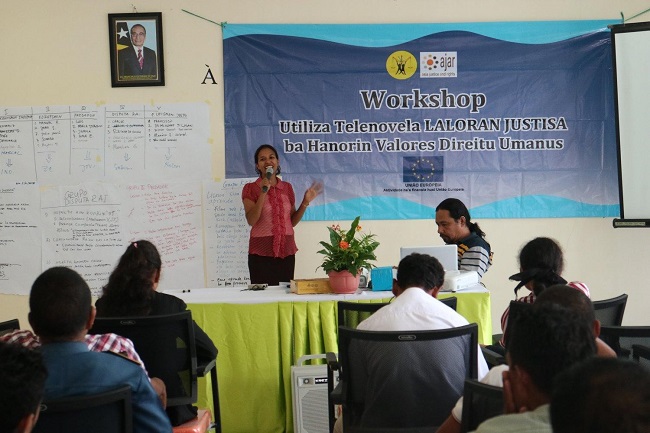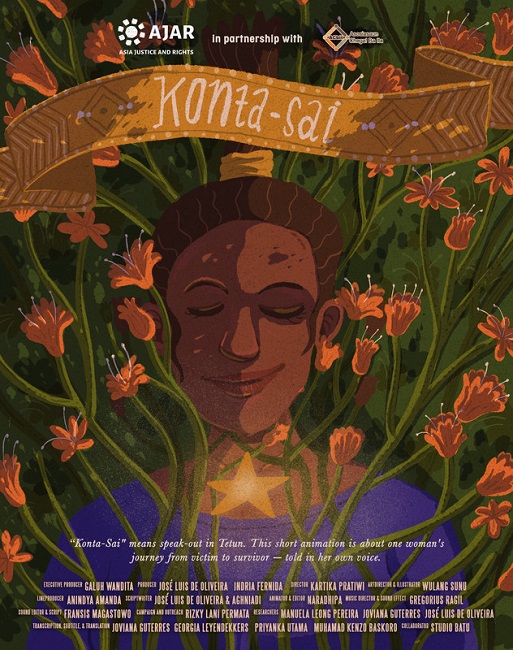Galuh Wandita and Aghniadi
“When I was a child my father once told me, ‘If you are ever apart from me, look at the sky.
If the sky is blue and the breeze is cool, it is a sign that your brothers and sisters miss you’.
That afternoon as I watched the sky behind my house, Dili felt near.”
The voice of Isabelinha de Jesus Pinto is heard narrating this vivid memory after her departure from Timor-Leste, in the opening minutes of the short documentary Nina & The Stolen Children (2016).
An estimated four thousand Timorese children were forcibly separated during the Indonesian occupation from 1975 to 1999. Isabelinha, or Nina, is part of a generation of children and their families who have been trying to find each other since then. Through the eyes of Nina and several others, the film chronicles this decades-long journey of search and eventual reunion. It offers a rare glimpse into the pain and lasting impact these abductions caused for both the children who were taken, and their families and communities who were left behind.
This documentary was years in the making, and is one of many films that Asia Justice and Rights (AJAR) have produced with victims and survivors of human rights violations in Asia-Pacific since 2013. AJAR’s work is dedicated to promoting awareness and understanding of rights and justice for all. It is through this process that we, as an organisation, have come to see the value of films as a vehicle for portraying the unspeakable, so that peers, family members, and others may understand and appreciate the full dimensions of the victims’ and survivors’ experiences.
Storytelling as healing
The development of Nina & The Stolen Children was instrumental for us in order to understand the role of documentaries as a means to raise public awareness about past human rights violations. Although the history of the 1975-1999 Indonesian occupation in East Timor is widely known, the story of the Timorese ‘stolen children’ is less so, if at all. Elsewhere in the world, such stories are recorded, including accounts of the Argentinian stolen children who were born in custody to political detainees and adopted by military families; and the Aboriginal stolen generation in Australia, who were taken from their families as part of a genocidal plan to eradicate a community.
Overtime, a multitude of stories about and from stolen children were uncovered by a small group of former abductees, human rights workers and organisations in Indonesia and Timor-Leste. Translating them into a digestible format was no easy task. In 2013, AJAR began compiling and editing footage of what would become Nina. We traded insights with photographer and filmmaker Anne-Cécile Esteve.
We traded insights with photographer and filmmaker Anne-Cécile Esteve. Our aim was rather simple: to accompany survivors with cameras and put them front-and-centre to tell their stories, as they see fit, when they feel it appropriate, and always putting them and their families first.

Nina ended up becoming a prologue to the many advocacy meetings AJAR had with government officials in both countries. The film was a very effective tool for helping ministries and national human rights institutions to imagine how proper policy responses would help the survivors and their families featured in the documentaries, for the better. The narrative of reuniting Timor-Leste families becomes a default to approach the issue of ongoing support for stolen children, and an entry point for understanding much wider, and still unresolved issues related to the past.
Storytelling as resistance
In August 2022, AJAR distributed cameras to Burmese filmmakers to create and showcase films that highlight the abuses taking place there. Given the extremely limited access that journalists and media outlets have had in covering the 2021 military coup, the Burma Transitional Justice Film Competition we held in 2022, unwittingly stood at the crossroads of movement and moviemaking. The competition showcased a set of raw, emotional, and creative short films portraying various aspects of life after the coup and in the midst of prolonged conflicts.
Due to privacy and security concerns, the screenings were held online with limited participants. Films were played through online webinars, displayed through shared screen, side-by-side, where the filmmakers can see audience’s faces, and vice-versa, seeing each other’s reactions at once. For a brief moment, the stories of Myanmar turned into communal experience, seeing footage that our Burmese friends did not only look at, but also actively participated in shaping and framing how they want to be narrated.

Since the 2021 coup filmmaking has become a dangerous activity in Myanmar, with numerous individuals involved being detained without any formal charges. Before this clampdown, Myanmar was poised for a cinematic renaissance with work made by a new wave of young Burmese filmmakers screened at prestigious international film festivals, such as Maung Sun’s Money Have Four Legs (2021), featured at Locarno Festival.
Storytelling as teaching aid, human rights educator
We feel that film has the potential to portray stories that are extremely personal and human; stories that frequently fall outside the spotlight of mainstream media and more importantly, do so in a way that is largely free of political prejudices. Other AJAR documentaries such as In Defiance (2015), a series of in-depth interviews with survivors of the 1965-1966 tragedy in Indonesia, and I Am Here/Sa Ada Di Sini (2017), a short documentary on the experiences of women victims of violence in the provinces of Papua and West Papua, were produced to provide the first – and perhaps only - exposure to suppressed histories and historically marginalised groups that have been ignored for far too long. These documentaries were screened in classrooms in Yogyakarta and Sorong. These are our ideal audiences, as different perspectives and ideas between students are encouraged and constructively engaged.
AJAR was also involved in writing scripts for a popular Burmese television drama The Sun, The Moon, and The Truth (2015), produced by the Myanmar Legal Aid Broadcasting Consortium. It was first broadcast nationwide across six channels to more than 5 million viewers, educating many about justice and rule of law issues. The lessons learned in Myanmar were then applied to the production of the Timor-Leste counterpart, Laloran Justisa (2017), a 20-episode television series screened on Timor-Leste national TV channel RTTL. We followed it up a year later with a manual designed to be used in training and discussions.
The participation of local collaborators, specifically Yangon Film School and Dili Film Works, helped us to present key information about human rights through the vehicle of drama and entertainment and thereby reach a broad audience. The stories featured a range of common problems experienced by the people in both countries. At that time, conventional distribution channels such as television, were vital for widening the reach. Production that enlisted the help of local civil society networks and government institutions can also ensure screenings of the works reach audiences beyond their initial airings.
Storytelling as documenting and re-contextualising historical events
In 2020-21, mobility restrictions brought on by the COVID-19 pandemic saw us redirect our efforts to produce campaign and advocacy materials in a safer manner. When the pandemic hit AJAR was in the middle of a process of documenting survivors’ stories in Aceh and Timor-Leste. We had gathered reams of field reports, interview transcripts, and correspondence with local organisations and victims and hoped to augment these with recordings in the field and the collection of additional archival materials.

When this was no longer possible, we came up with the idea to instead rework our existing materials into an animation film, as had been done by then-AJAR staffer and documentarian Kartika Pratiwi with her 2019 short film A Daughter’s Memory. Thus, Konta-sai and 8:45 (2021) were created. The films draw on survivors’ accounts from Timor-Leste and Aceh respectively, and their journeys of healing after abuse, then concluding in their testimony at each respective truth and reconciliation commission hearing. The films were narrated by the survivors themselves. Animation is a relatively novel approach for documentary, a form that is traditionally and most frequently characterised by live-action and non-dramatisation, particularly in the case of reenacting testimony and ‘documenting the undocumentable’. Both short films underwent months of back-and-forth efforts to ensure each illustrated frame was accurate or at least representative of what the survivors imagined.
Our project in Myanmar, Healing Wounds (2022) used the same approach, yet due to the sensitive nature of the subject matter and out of concern for the safety of those involved, the protagonist became an amalgamation of multiple survivors’ accounts. The film makes use of animation’s capability to visually weave and depict the collective experience of Burmese women living through armed conflicts.
As we look at and think about films and stories now – the ones that have watched, the few we produced, those we have screened in one part of the world to another – our aims, perhaps, are only to spark a prairie fire of change. In the gaps between these various representations from Nina to Healing Wounds, we come closest to seeing how the truths of any justice process remain elusive, even when so many important facts and insights are revealed. For all the everyday and ordinary details that are not captured in reports but remembered fondly by survivors; films, both fictional and documentary, offer a medium for them to share their stories with a wider audience. Such stories can promote reconciliation and healing by bringing people together in a space of dialogue and reflection, to confront the past and work towards a better future.
Galuh Wandita (gwandita@asia-ajar.org) is the Executive Director of Asia Justice and Rights (AJAR). Aghniadi (aghniadi@asia-ajar.org) is a Regional Communication Coordinator at Asia Justice and Rights (AJAR).



